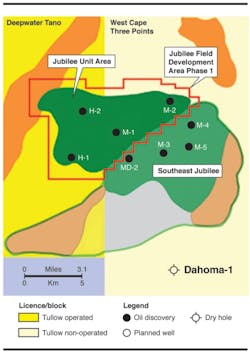Jubilee brings Ghana into deepwater fold
Nick Terdre
Contributing Editor
Production was due to start this month on the Jubilee field off Ghana, catapulting the West African country into the ranks of deepwater producers with its first offshore development.
Despite its size the project is also a genuine example of a fasttrack development, achieving first oil within three and a half years of discovery – no mean feat given that peak oil production will be 120,000 b/d. Tullow Oil, the field unit operator, describes it as the “fastest ever full-scale deepwater development.”
The Jubilee field lies in water depths of 1,100-1,700 m (3,609-5,577 ft), around 60 km (37 mi) off the coast of western Ghana. It straddles two licenses, the Tullow-operated Deepwater Tano and Kosmos Energy’s West Cape Three Points, which have almost the same line-up of licensees. Unitized interests are: Kosmos 23.49%, Tullow 34.71%, Anadarko Petroleum Corp 23.49%, Ghanaian company EO Group 1.75%, Sabre Oil and Gas 2.81%, and state oil company Ghana National Petroleum Corp (GNPC), 13.75%.
As technical operator, Kosmos is operating the Phase 1 development. Tullow will take over operatorship in the production phase. Development is based on 17 subsea wells tied back to a leased FPSO. Kosmos puts recoverable oil reserves for this phase at 300MMbbl. Earlier this year Tullow estimated the final cost of this phase at US$3.35 billion, compared with the original budget of $3.15 billion.
Initial production will be around 30,000 b/d, ramping up to a peak of 120,000 b/d within six months as new wells are brought on stream. Water injection will be operative from the start and gas injection shortly thereafter. Gas will also be injected into the production risers to lift the wellstream.
At full oil production, gas output will reach 120 MMcf/d. Of this, 20 MMcf/d will be harnessed as fuel on the FPSO, 30 MMcf/d will be injected, and the remaining 70 MMcf/d will be exported to shore to meet Ghana’s energy needs – the government has approved use of the gas in a new power generation plant. The gas export project could be onstream within 24 months of start-up. Technip, one of the Jubilee contractors, has been assigned by GNPC to lay the 14-km (8.7-mi) deepwater part of the pipeline to shore. The Jubilee partners have agreed to supply the first 200 bcf to GNPC at no cost.
The development has been managed by an integrated project team set up in February 2008, led by Kosmos, and including representatives from all the main partners. The Phase 1 plan was approved by the government in July 2008.
Chief contractors are Modec for the FPSO, Technip (supply and installation of flexible flowlines and risers), FMC (19 subsea trees) and Aker Solutions (fabrication and subsea construction). The partners sought where possible to rely on existing, proven technology, which benefited the fasttrack commitment. According to a Tullow statement, “proven contractors have used proven designs to meet functional rather than truly precise specifications. This has resulted in some quite dramatic schedule reductions when benchmarked to general industry performance.”
The FPSO contract with Modec was agreed in August 2008. The ship is designed to remain on the field for up to 20 years: in addition to oil production, it will provide water injection capacity of 230,000 b/d; gas injection/compression capacity of 160 MMcf/d of gas; and oil storage of 1.8 MMbbl. It also has accommodation for 120 personnel.
The FPSO, namedKwame Nkrumah in honor of Ghana’s first president, was converted from the VLCC tanker Tohdoh at Sembcorp Marine’s Jurong yard in Singapore. Here too a tight schedule was set and adhered to by both the yard and its subcontractors.
Aker Solutions fabricated the water treatment modules at its Port Klang facility in Malaysia; VME Process constructed the oil processing facilities at its Batam, Indonesia, yard; Dyna-Mac Engineering Services in Singapore built the gas compression modules; and Malaysia Marine and Heavy Engineering in Pasir Gudang, Malaysia, supplied the external turret for the single point mooring system. This device, located at the vessel’s bow, is said to be one of the largest of its kind engineered to date.
The FPSO was delivered in June. It sailed to Ghana under its own steam and was installed on the field in July. The turret is held in place by nine mooring legs attached to suction anchors in three groups of three. Aker Solutions’ new subsea construction vesselSkandi Aker installed these anchors as its maiden assignment.
The 17 subsea wells called for in Phase 1 comprise nine producers, six water injectors and two gas injectors. Two of these are the original discovery wells – one on each license – which have been re-completed for production and water injection, while the others are new. The wells, positioned at eight drill centers, are targeting either the Upper or the Lower Mahogany reservoir. Five of the drill centers serve producers, two water injectors, and one gas injectors.
At each drill center the wells are tied into four-slot manifolds supplied by FMC – the production manifolds each weigh around 100 metric tons (110 tons) and the injection manifolds 80 metric tons (88 tons). The wells are not clustered closely around the manifolds but in most cases located at a distance.
Delivery of subsea equipment, fabricated in the UK, Singapore, USA, France, Finland, Norway, and Ghana began early this year, allowing a nine-month period of subsea installation to get under way in January. Altogether around 40 km (24.8 mi) of flowlines connect the manifolds to the FPSO, with 28 km (17.4 mi) of umbilicals for controlling operations. In the case of the production manifolds, each is served by a pair of insulated flowlines. A fleet of 14 vessels was employed for subsea construction and pipelay, supported from a base in Takoradi-Sekondi port in western Ghana.
Development drilling has mostly been performed by the Ocean Rig semisubmersibleEirik Raude. Drilling of the first-phase wells finished in the first quarter of 2010, after which Eirik Raude moved onto completions. A hiccup caused by a mechanical failure in the first well, J-01, necessitated a workover. But the completion of J-02 went as planned, and this well should deliver over 25,000 b/d of oil. To make up for time lost with the J-01 workover, the semisubmersible Sedco 702 was brought over in September to work alongside Erik Raude.
Jubilee was discovered in mid 2007 by a pair of wildcats, Mahogany-1 on the Deepwater Tano license and Hyedua-1 on the West Cape Three Points license. It was not long before it became clear that the field held substantial resources. The latest P50 estimate of reserves in the unit area is 700 MMbbl, with a P10 upside of 1 Bbbl. Reservoir connectivity is proven over a distance of 6 km (3.7 mi). The crude is light and sweet, with a density of 37.6º API and a modest sulfur content of 0.025% by weight. Production characteristics are good, and the production wells are each expected to deliver 20,000 b/d.
Further stages of development of the main Jubilee field are already being planned. Phase 1a will involve five to eight infill wells tied into existing infrastructure, while Phase 1b could bring up to 20 additional wells, but this would likely to require expansion of the subsea facilities. There is spare capacity for additional risers in the FPSO turret.
The timing of these phases will depend on the performance of the Phase 1 wells but sanction is likely within the next one to two years, according to Tullow.
The Phase 1 development does not include Jubilee South-East, which lies entirely in the West Cape Three Points license. The Mahogany-3 appraisal well encountered additional underlying sand known as Mahogany Deep. This was confirmed by the Mahogany Deep-2 appraisal well in late 2009/early 2010. The appraisal of Jubilee South-East was completed by the Mahogany-5 well in mid 2010, which found somewhat heavier crude of 28-32º API. Work continues to define the potential resource range, but a P10 figure of 500 MMbbl has been mentioned.
In September, Kosmos filed a declaration of commerciality for Jubilee South-East. A development plan should be submitted in February 2011, with stand-alone and Jubilee tieback options under consideration.
But there are other prospects on the two licenses which the partners have begun investigating. A total of eight exploration wells and eight appraisals have been drilled so far on Jubilee and the other prospects. Of the exploration wells, only two have been duds. The results of the appraisal wells have either met or exceeded pre-drill expectations.
The exploration campaign led to the discovery of Odum in early 2008, Ebony in late 2008, Tweneboa in early 2009, and Owo in mid 2010. Odum, which lies in the West Cape Three Point license, was successfully appraised in 2009 and is seen as a potential satellite development to Jubilee.
Tweneboa and Owo are adjacent structures to the west of Jubilee in the Deepwater Tano license. Both contain light oil – Owo-1, which was drilled at a tophole location 6 km west of the Tweneboa discovery well, found a significant column of high quality 33-36º API oil.
A sidetrack to the east in Owo-1 in September confirmed an extension of the oil column and identified both condensate and gas pays. According to Tullow’s resource estimate at that time, the P50 estimate for Owo oil was 200 MMbbl, with a further 250 MMboe of Tweneboa and Owo hydrocarbons. The two structures are part of a fan complex with a third lobe, Ntomme, which has yet to be drilled. A three-well appraisal program was due to begin in November. Development studies are also under way with a view to bringing Owo and Tweneboa on- stream in 2012.
Offshore Articles Archives
View Oil and Gas Articles on PennEnergy.com




